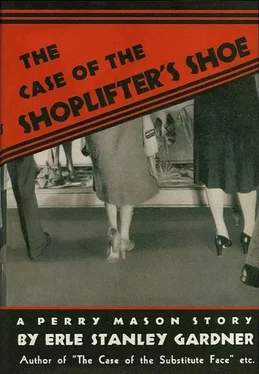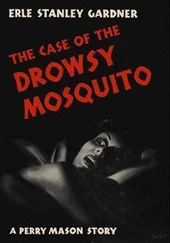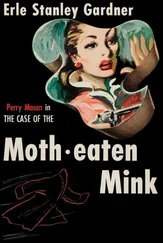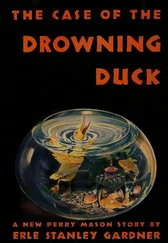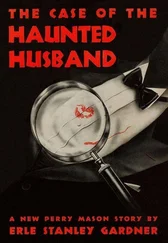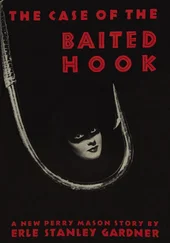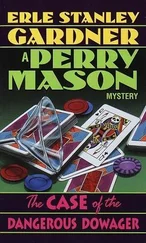“Sometimes,” Sampson said, “if the Court will pardon the interruption, a prosecutor deems it necessary to change his trial tactics in order to meet varying conditions which develop during the trial.”
“I understand that,” Judge Barnes said, “but this evidence is clearly proper. It would have even been proper on cross-examination. This witness is now called by the Defense. The objection will be overruled. Did you develop latent fingerprints on that coin, Sergeant Holcomb?”
Sergeant Holcomb said, “Yes.”
“Did you,” Mason asked, “take fingerprints of the defendant in this case?”
“Yes.”
“Did you compare the fingerprints of the defendant with the fingerprints on the copper coin?”
Sergeant Holcomb said, “She was wearing gloves. She wouldn’t have left any fingerprints.”
“I’m not asking that,” Mason said. “I’m asking if you compared the two fingerprints.”
“Yes.”
“Were they the same?”
“No.”
“Now then, if the Court please,” Mason said, “I would like to have Sergeant Holcomb produce photographs of the fingerprints which were developed on that penny, and give the witness, Drake, an opportunity to demonstrate that these were the fingerprints of Pete Chennery, a man with a known criminal record.”
“I object to that. I object to the statement. I object to the procedure, and I object to the manner in which this offer is made before the jury,” Sampson said. “It is an attempt to cloud the issues. The Court has already ruled that the witness, Drake, has no means of knowing whether the fingerprints which he took are those of Pete Chennery.”
“Do I understand that the Prosecution wishes to keep the Defense from showing the identity of the person who placed that copper coin in the light socket?” Judge Barnes asked.
“I fail to see where it has anything to do with the present case,” Sampson said. “It’s simply going to cloud the issues. Let us suppose that some person did enter the dwelling for the purpose of robbery at some time prior to the murder. That has nothing to do with this case.”
“No,” Judge Barnes said ominously, “but suppose that person entered the dwelling at the time of the murder? ”
“In that event,” Sampson said, “it makes no difference who that person was. There is already evidence before this Court showing that the fingerprints on the copper coin were not the fingerprints of the defendant. That’s all that the defendant is entitled to show... That is, Your Honor, I don’t want to appear in a position of blocking any legitimate proof, but from a technical standpoint, the defendant is only entitled to prove that she did not participate in the commission of a robbery or in short-circuiting those lights. Having once established that fact, the identity of the person who did tamper with the lights becomes absolutely incompetent, irrelevant and immaterial, unless it is shown that such person was acting in a conspiracy with the defendant. And the Prosecution makes no claim that such is the case.”
Mason threw up his hands. “All right. If the Prosecution doesn’t want the jury to know who killed Austin Cullens, I’m not going to waste my time trying to do their work. The question is withdrawn. The witness is excused.”
Sampson said, “That’s unfair. You’re just trying to razzle-dazzle the jury.”
Mason shouted, “You’re the one who’s...”
Judge Barnes banged with his gavel. “Gentlemen,” he said, “we will have order in the court. There will be no more such remarks. Mr. Mason, your remark was improper and uncalled for. Mr. Sampson, your accusation as to Mr. Mason’s purpose in asking questions was entirely out of order. The Court would administer a more stem admonition to you, Mr. Sampson, were it not for the fact that Mr. Mason’s remark which called forth your statement, was so obviously improper. The fact remains, gentlemen, that we are going to have no more personalities injected in the case. This is the Court’s last warning.”
Mason sat back and said resignedly, “All right. That’s the defendant’s case.”
“You mean you quit?” Sampson asked.
Mason glanced up at the Court and said, “Since I must address my remarks to Your Honor, may I suggest to the Court that the Court advise Counsel for the Prosecution that when the defendant announces, ‘That’s the defendant’s case,’ it is improper for the prosecution to seek to capitalize on that by addressing remarks to Counsel. As a matter of fact, I believe the jurors will understand that the Defense has made every effort to solve this case, and that the only reason the Defense has not solved it is...”
“Careful, Mr. Mason,” Judge Barnes frowned.
Mason finished with a smile. ” ‘Only too obvious,’ were the words I was going to use, Your Honor.”
Judge Barnes said, “Do you wish to argue the case, gentlemen?”
Sampson did, and his argument sought to go just as far as a district attorney dared to go in commenting on the failure of a defendant to deny the charges which had been made against her. He brought forward the defendant’s shoe, which had been introduced in evidence, pointed to the telltale stain on the sole, and challenged counsel to explain how that stain got on the shoe if it did not indicate the guilt of the defendant. “Standing, as it does,” Sampson thundered, “unchallenged, undenied and uncontradicted.”
He cited the attempt of the defendant to bring in some mythical criminal, who must have entered the house and, by implication, killed Austin Cullens, and, above all, excoriated Mason for his attempt to becloud the issues by confusing Sergeant Holcomb and mixing up the bullets.
When he had finished, Mason approached the rail, to stand in front of the jurors with a smile. “Ladies and gentlemen,” he said, “the Court will instruct you that in order to warrant a conviction on circumstantial evidence, the circumstances must not only be consistent with the guilt of the defendant, but inconsistent with every other reasonable hypothesis. In the event there is any reasonable hypothesis, other than that of guilt, on which the circumstantial evidence can be explained, then it becomes your duty to acquit the defendant.”
“This is a case in which the Prosecution relies on circumstantial evidence. As far as the gun is concerned, that evidence has proven a boomerang. The evidence proves conclusively that the gun found in the defendant’s handbag — and I will admit to you, ladies and gentlemen, that it is the defendant’s handbag, not that she has told me so, because her mind is a blank as to what transpired, but because I think it’s a fair inference from the evidence; that it was her handbag — that gun did not kill Austin Cullens. But that gun did kill George Trent. There are only two bullets in the case. If the bullet from the Breel gun didn’t kill Cullens, then it must have killed George Trent. Now then, on the evening Cullens was killed, there was only one shot fired from this gun. That one shot was fired by Austin Cullens at someone who was in the room with him. That shot lodged in the back of a chair. Cullens carried that revolver in his right hip pocket — which was the reason the coroner’s examination disclosed nothing in that pocket.
“Now then, gentlemen, what is more reasonable than to suppose that Mrs. Breel guessed that her brother was dead, and strongly suspected that Austin Cullens had killed him. Austin Cullens had every reason to want George Trent out of the way. There is every reasonable inference to indicate that George Trent had uncovered evidence which, when communicated to the police, would convict Cullens of a series of gem robberies.
“Therefore, Cullens killed Trent, In order to cover up that killing, he did various and sundry things, such as pretending that Trent had pawned gems with a gambling house. And to bolster up that claim. Cullens even went to the gambling house and put on an act, trying to establish a false motive for Trent’s death.
Читать дальше
